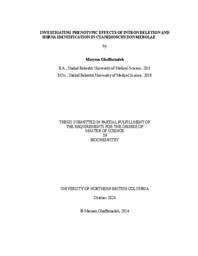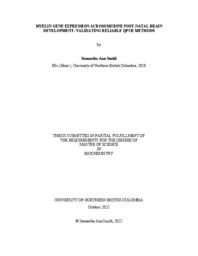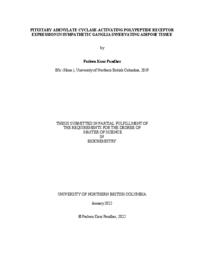Furber, Kendra
Person Preferred Name
Kendra Furber
Related Works
Content type
Digital Document
Origin Information
Content type
Digital Document
Origin Information
Content type
Digital Document
Origin Information
Content type
Digital Document
Description / Synopsis
Acetylcholinesterase is a hydrolase enzyme known for its major role in neurotransmission regulation by breaking down the neurotransmitter acetylcholine at the synapse after every electrochemical signal is successfully relayed between two adjacent neurons. In a healthy human brain, it retains itself on the extracellular surface of neurons, concordantly paints up an artistic beautiful web of an intricate neural network upon staining. However, in an aging human brain experiencing neurodegeneration, the network collapses into plaques that are neurotoxic to the brain. At the center of these individual plaques are heavily aggregated amyloid-beta peptides and fibers enveloping the neurons. This is most often one of the specific traits of Alzheimer’s and Parkinson’s disease, two most common neurodegenerative diseases. Many studies have provided experimental evidences of stable co-localization and fiber growth promotion existing between the amyloid-beta peptides and acetylcholinesterase. Nevertheless, the specific chemistry and mechanism of how the relationship between the amyloid-beta peptides and acetylcholinesterase is formed and maintained, still remains tentative to date. Most neurodegenerative diseases remain incurable, and most of the available medical treatments focus on alleviating the symptoms and mitigating the disease progression, for instance through the use of acetylcholinesterase inhibitors. But with drawbacks related to treatment effectiveness and undesirable side effects of the current available acetylcholinesterase inhibitors, the continued search for more effective acetylcholinesterase inhibitors has never ceased. The objectives of this in vitro study were to examine four small molecules and twenty-one mushroom extracts for their ability to inhibit acetylcholinesterase activity. To perform the screen, an enzyme assay using Ellman’s reagent DTNB was used. The assay utilizes thiocholine produced from the hydrolysis of acetylthiocholine by acetylcholinesterase to reduce DTNB into TNB2-, a colorimetric product that can be used to monitor the changes in the acetylcholinesterase activity level in the presence or absence of inhibitors. Using the established acetylcholinesterase assay, none of the four small molecules showed any inhibitory effect on acetylcholinesterase activity. On the contrary, eight of the mushroom extracts were found to inhibit the acetylcholinesterase activity. These eight extracts were prepared from five mushroom species that have not been extensively researched nor reported for acetylcholinesterase inhibition. Surprisingly, for the remaining thirteen mushroom extracts that did not show inhibition, they were found to enhance the acetylcholinesterase activity. Albeit the unexpected irrelevance to the focus of the study, these thirteen extracts could be useful as biological tools in the general research of regeneration, as acetylcholinesterase has been reported to act as a mediator promoting cell proliferation and regeneration.
Origin Information
Content type
Digital Document
Description / Synopsis
Myelination is essential for proper conduction across all neural networks. Myelination in the central nervous system is performed by glial cells called oligodendrocytes. Mature, myelinating glia develop from progenitor cells through distinct differentiation steps, and gene expression markers have been established that are unique to oligodendrocyte lineage cells. This study aims to establish a reliable RT-qPCR protocol to quantify oligodendrocyte-specific gene expression according to the MIQE guidelines. Primers specific to the progenitor, immature, and myelinating stages of oligodendrocyte differentiation were validated, showing 90-100% efficiency. Reference gene primers were also validated, and their stability was determined to make recommendations for those to use as normalization factors. The expression pattern of oligodendrocyte-specific genes across stages of postnatal development was similar to previously defined RNA-seq profiles in isolated cell types. The validated RT-qPCR assays developed build a framework for future investigation on myelination during development and remyelination in disease.
Origin Information
Content type
Digital Document
Description / Synopsis
Obesity is a disease that occurs when energy intake exceeds energy expenditure, concomitantly increasing risk of chronic diseases, including metabolic diseases such as diabetes. Research into therapeutics to correct dysregulations in energy balance is on the rise, and one notable neuropeptide being studied is pituitary adenylate cyclase-activating polypeptide (PACAP). PACAP has been shown to regulate thermogenesis, an energy burning process regulated by the sympathetic nervous system (SNS) in response to cold stress and overfeeding, but its role within the sympathetic nerves innervating and regulating energy metabolism in adipose tissues is not well understood. We hypothesize that PACAP is acting on PACAP receptors (PAC1, VPAC1, VPAC2) expressed in stellate ganglia innervating brown adipose tissue, the main thermogenic organ in mammals. We have established a reliable protocol for the isolation of two ganglia of the SNS (stellate and superior cervical) and provided recommendations of reference genes to use as internal controls for gene expression studies. For the first time, we confirmed PACAP receptor gene expression in the stellate ganglia, and saw sex-specific, differential gene expression based on housing temperature. We subsequently analyzed the expression of PAC1 splice variants in the stellate ganglia and our positive control tissues (adrenal gland and superior cervical ganglia), identifying at least two variants in these SNS tissues. This work adds to current literature on the study of thermogenesis and energy balance, and encourages future work characterizing G-protein coupled receptors (GPCRs) for their therapeutic application, enhancing our fundamental understanding of autonomic physiology in mammals.
Origin Information






